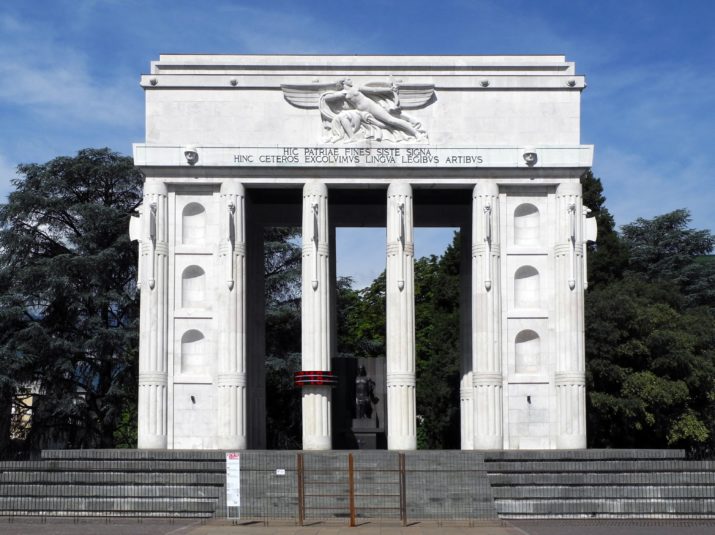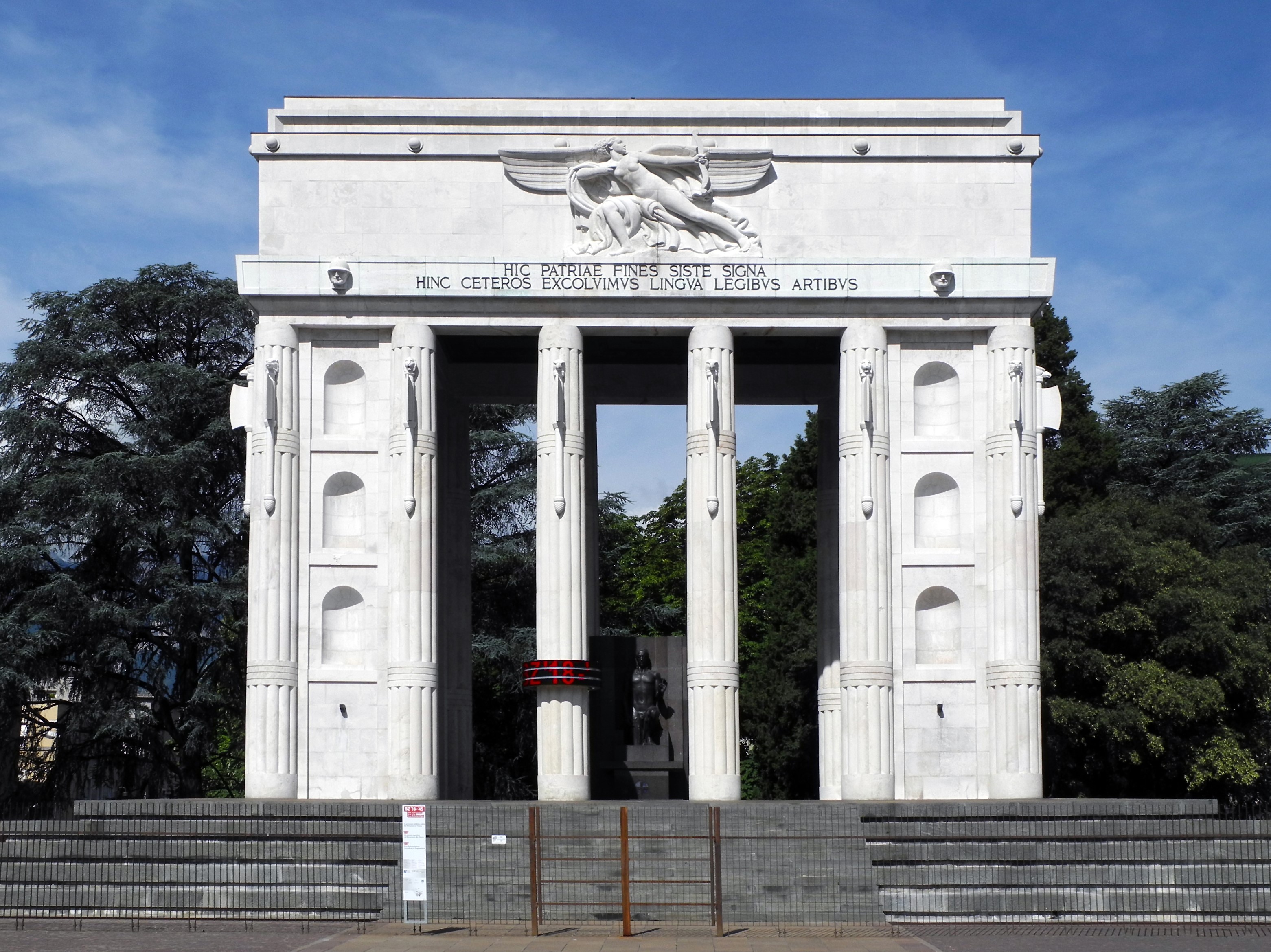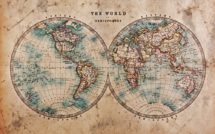
Coming to Terms with Controversial Memories in South Tyrol: The Monument to Victory of Bolzano/Boze

This is part of our special feature, United in Diversity.
The richness of Europe’s cultural heritage and diversity is embodied in the striking monuments and historical buildings that dot the continent, but many of these artifacts also talk of difficult times and remind of the darker history of Europe—its wars, its violence, the sufferings of its people that lie behind today’s union of democratic nation-states. This difficult past makes them potential sites of conflict and contestation. From war memorials to the architectural relics of Fascism, Nazism, Communism, and Colonialism, controversial heritage sparks debate and controversies worldwide.
The potentially divisive nature of cultural heritage was addressed in the Framework Convention on the Value of Cultural Heritage for Society (Faro Convention) adopted by the Council of Europe in 2005. The Convention links heritage to human rights and democracy, and highlights that its importance derives mostly from the meanings and values attached to it by people. In this context, the Convention defines a heritage community as not necessarily linked by language, ethnic ties, or even a shared past, but focuses instead on the creation of a “common heritage of Europe” as an inclusive, creative, and transformative process. Aware of Europe’s troubled past, article 7 of the Convention highlights the need to address disagreements over the interpretation of cultural heritage, in order to foster processes of reconciliation, mutual understanding, and dialogue.[1]
The challenges that are inherent in cultural heritage and addressed by article 7 of the Faro Convention are epitomized in the Monument to Victory of Bolzano/Bozen, a white marble arch built by the Fascist regime in South Tyrol, a province in Northern Italy bordering Austria and Switzerland, and inhabited by a German and Ladin minority. In this region, characterized by a past of ethnic tensions, the Monument to Victory has remained a controversial symbol: for some, it commemorates fallen soldiers and Italian heritage; for others, it is a symbol of injustice and repression of the Italian state toward the province’s minorities. Recently, an exhibition was opened inside the Monument to Victory to contextualize its history and its meanings in the broader context of the region’s past and to bridge South Tyrol’s divergent memory cultures. The 39th European Museum of the Year Award gave a “special commendation” to the exhibition, praising it for reintegrating a controversial monument and being a “highly courageous and professional initiative aimed to promote humanism, tolerance, and democracy.”[2]
This contribution explores the symbolic and political power of heritage objects, as well as the challenges associated with overcoming legacies of historical conflicts particularly in multiethnic societies, through narrating the Monument to Victory’s history over the years, from its erection in the 1920s to the opening of the exhibition in 2014.
South Tyrol and the Monument to Victory
South Tyrol, with its predominantly German-speaking population and a small Ladin minority, was part of the Habsburg Empire up until World War I. It was promised to Italy when Italy joined the Entente and became formally part of the state in October 1920. When Mussolini took power in Italy, the fascist government started an Italianization process in the region, prohibiting the use of the German language in public spaces, closing German-language schools, and Italianizing German names. In addition, the regime started a program to industrialize the province in order to attract Italian-speaking workers from the rest of the peninsula. The Italian-speaking population grew from 7,000 people in 1910 to more than 100,000 in 1943. In 1939, an agreement between Mussolini and Hitler forced South Tyroleans to decide whether to emigrate to the Third Reich or remain in South Tyrol and accept the Fascist Italianization program. 86 percent of South Tyroleans voted for leaving, but because of the start of the war only about 37 percent actually left and many of them returned after the war.[3]
The Fascist process of the Italianization of South Tyrol was not limited to discriminatory policies and demographic changes, but also included the Italianization of the urban landscape, as epitomized in the Monument to Victory. Designed by the architect Marcello Piacentini, it was erected on the site of an Austrian war memorial in 1928. With its lictorial columns, the Latin inscription “Here at the border of the Fatherland, plant the insignia / From here we educated the others with language, law and the arts,”[4] the sculptures of Italian patriots and the Victory Sagittarius, and a female archer shooting northwards (toward Austria), “the entire symbolism of the monument expressed the conquest of South Tyrol and its economic, infrastructural and cultural penetration.”[5]
After World War II, Italy and Austria signed the Gruber-Degasperi agreement to protect the German-speaking minority in South Tyrol. However, the Italian state implemented the agreement poorly and, as a consequence, a wave of protests and tensions emerged in the late 1950s. Not surprisingly, the Monument to Victory became one of the sites of protest. Already in 1943, after the fall of Mussolini, a group of Nazi sympathizers damaged the monument. In 1978, a bomb exploded near the monument and a year later a political activist carried out a hunger strike in front of it. Consequently, the monument was closed off with a fence.
Ethnic tensions started to ease off when in 1972 the Second Statute of Autonomy came into effect, providing a more extensive territorial autonomy to South Tyrol and additional measures to protect the German and Ladin minority populations, such as the proportional representation of linguistic groups in provincial government bodies, the distribution of public employment and public resources among linguistic groups in proportion to their numerical strength, mandatory bilingualism of public signs and public officers, and mother tongue education. Today, ethnic tensions have mostly vanished. Although some separations between the South Tyrolean linguistic groups remain in parts of social and political life, recent studies show that there has been a significant increase in the level of mutual trust, interaction, and cooperation between the political, economic, and intellectual elites of the various South Tyrolean language groups as well as the development of inter-ethnic initiatives within civil society.[6]
However, for decades these positive developments did not include the Monument to Victory. Used by Italian-speaking nationalists as a place for commemorative ceremonies and, until 1997, the locus of military ceremonies, the monument remained “the focal point of battles over politics, culture, and regional identity.”[7] Like a “boulder that history has forgotten to remove,”[8] it continued to spark debates: Italian right-wing parties considered it part of Italian national heritage and called for its preservation, while German-speaking right-wing politicians called for its demolition. More moderate proposals by other political actors included the removal of overtly fascist symbols on the monument, changing its name or adding information panels to contextualize the monument historically.
BZ 18—45: Bridging South Tyrolean Divergent Memories?
In 2011, the Italian state, the South Tyrolean government, and the municipality of Bolzano/Bozen agreed to create a commission of historians and art historians, composed of members from the Italian and German-speaking language groups and of municipal, provincial, and state representatives, with the goal to provide an historical contextualization for the Monument to Victory, narrating its story and the political-social context it was created in. Predictably, the decision sparked debates and criticisms in parts of both the German and Italian speaking South Tyrolean worlds.
Two features of the Commission should be highlighted in order to explain how it navigated such an environment. First, the president of the Commission, Ugo Soragni, managed to obtain a non-interference clause from politicians in order to protect the work of the Commission from political influence. As pointed out by a member of the Commission, “We knew that if politics had entered our discussions, or if all our plans and texts for the exhibition would have needed to be approved by the Provincial Government, nothing would ever have come out of it. Our work would have been impossible.”[9]
Second, in pursuing the goal of telling the history of the monument and the region, the members of commission were aware that it would have been impossible to avoid the contestation of historical narratives and facts. Thus, rather than searching for consensual aspects and harmonizing contrasting sets of memories, the commission, instead, embraced the multifaceted meanings of the monument in order to transform it into a place for critical reflection about history and heritage. As it was impossible to please everyone, they realized that they “had to displease everyone.”[10] For example, the exhibition highlights not only the process of Italianization of South Tyrol, but also the public infrastructure constructed during the Fascist regime.
In 2014, the permanent exhibition “BZ 18-45. One Monument. One Town. Two Dictatorships” was inaugurated in the subterranean spaces of the Monument to Victory, exploring the monument’s history against the backdrop of the historical context of 1918-1945 with a focus on the period of Fascism and National Socialism in South Tyrol. The permanent exhibition seeks to open up a dialogue between the differing interpretations of the monument’s role in South Tyrol’s heritage through five main features. First, a LED scrolling text running around one of the lictorial columns on the front of the Monument was added; the rest of the monument’s exterior was left untouched. The purpose of the LED ring is to engage and neutralize the Fascist ideology of the monument with lightness and irony.[11] It “marks the difference between the totalitarian then […]” and “a now characterized by cultural pluralism and tolerance.”[12]
Second, as visitors enter the monument, they pass through a sound and video installation that blurs and layers typical Nazi and Fascist anthems and slogans “into an acoustic parallel to the overpowering dominance of the Fascist architecture.”[13] In the monument’s crypt, an original text frieze pays homage to glory, virtue, and honor. In order to “neutralize” the Fascist rhetoric, “illuminated writing” of phrases for democracy and against dictatorship by Hannah Arendt, Bertolt Brecht, and Thomas Paine is projected directly onto the text frieze.[14] This “clear, moving light” outshines the “heavy, static darkness.”[15] Fourth, the main exhibition is organized into three different, but connected paths: an external path telling the region’s macro-history from 1918 to 1945; an internal path on the micro-history of the monument; and four thematic corners focusing on the question “What is a monument?” Finally, considering the delicate equilibrium between the Italian and the German languages in South Tyrol and the policy of bilingualism in the province, the Commission decided to use English as the first language of the exhibition (followed by Italian and German) to avoid sparking debates over the primacy of one local language over the other.[16] Some criticisms were, however, raised because Ladin, the third official language of South Tyrol, was not included in the exhibition signs; translation of information material in Ladin was carried out successively.[17]
With the permanent exhibition inside the monument and the external LED ring, the Monument to Victory has assumed new meanings today and has become “a radically different monument, a monument 2.0.”[18] In line with the Faro Convention, the exhibition has opened up a dialogue between the differing interpretations of the monument, giving visitors the possibility to enter and explore it both from outside and inside, reflecting critically on its roles and meanings as well as the past and future of South Tyrolean society. It has thus transformed the Monument into an open space for critical reflection that belongs to everyone and where one can “discuss, ask questions, and look for possible answers.”[19] Local and national politicians, both German and Italian speakers, have praised the ‘new’ monument and the exhibition, described as a space “to learn the historical bases of cohabitation and to build a future of peace;” “a step toward cultural pluralism, plurilingualism and […] European citizenship;” and a symbol of re-pacification.[20]
Not everybody shared this enthusiasm for the process of historicization of the Monument to Victory: some Italian nationalists complained that the LED disfigured the monument; German-speaking nationalists continued to call for the removal of the fascist monument as the only possible solution. However, these remained marginalized voices. If previously the monument had been used (and abused) primarily by right-wing extremists who used its symbolic power to divide and sow discontent, the controversies surrounding the monument have largely been neutralized. As the historian Hannes Obermair writes, “from a monument conceived in the twentieth century by and for fascism, it is now a monument for the new millennium; reinterpreted by a democratic society that believes in the values of participation, tolerance and respect for humanity.”[21] The Monument has become a site of reflection and dialogue across social or ethnic categories that would have been lost had the monument been taken down.
Conclusions: Coming to Terms with Controversial Memories
The narrative surrounding the Monument to Victory shows that heritage objects are not just elements of the land- or cityscape, nor simply “what is left from the past.” Instead, they play a key role in society today. They embody collective memories and articulate identities. As such, they do not only represent the past, but are projected toward and interact with the present and the future. Thereby, heritage artifacts are key tools employed in processes of construction of a society’s common history, identity, and continuity.
Because of these roles, they are potential site of conflict. Indeed, while part of the population may consider a monument a reflection of a shared narrative and a sense of belonging, “those who cannot see themselves reflected in its mirror cannot properly ‘belong.’”[22] These excluded and marginalized people might contest and rewrite the dominant narrative attributed to monuments. The monument becomes a site of contestation between divergent collective identities and memories. Culturally diverse societies, like South Tyrol, are particularly prone to this type of conflictual development, as monuments and cultural artifacts play a key role in shaping ethnic relationships and ethnic politics.
For decades, the Monument to Victory was a symbol of division, representing controversial meanings for South Tyrolean linguistic groups. However, with the exhibition BZ ’18-’45, the tensions and discussions about the monument among the South Tyrolean linguistic communities have been defused. Embodying the spirit of the Faro Convention, the monument has become a locus of encounter of, and reflection on, the different perceptions of South Tyrol’s history and memories, and has emerged as a tangible symbol of the progress made in South Tyrol in terms of a largely peaceful coexistence between language groups.
The narrative of the Monument to Victory is relevant not only for South Tyrolean society. It can be a source of inspiration for other European societies and the European Union project as well. We do not propose the developments surrounding the Monument to Victory as a blueprint for other contexts. Rather, it raises awareness that it is indeed possible to reframe controversial artifacts into sites of, if not reconciliation and unity, than at least reflection and mutual understanding. In this way, the recent story of the Monument to Victory gives further content to the EU’s motto “united in diversity, in terms of its commitment to provide space for the coexistence of multifaceted viewpoints inherited by a complex past in order to pursue a common destiny.
Andrea Carlà is Senior Researcher at the Institute for Minority Rights of Eurac Research in Bolzano, Italy. His research focuses on the interplay between minority protection, migration policies, and security issues.
Johanna Mitterhofer is a researcher at the Institute for Minority Rights of Eurac Research in Bolzano/Bozen, Italy. Her research interests are second generation youth, the changing nature of heritage, and migrant inclusion policies at the local level.
For a related argument, see the longer publication: Andrea Carlà and Johanna Mitterhofer, “Transforming a Controversial Heritage: The Case of the Fascist Victory Monument in South Tyrol,” Acta Universitatis Carolinae. Studia Territorialia XVII, no. 2 (2018).
References
[1] See https://www.coe.int/en/web/culture-and-heritage/faro-convention, accessed March 20, 2019.
[2] Cited in Sarah Franzosini, “Un premio che conta,” Salto.bz, April 4, 2016, www.salto.bz/it/article/11042016/un-motivo-di-orgoglio, accessed March 20, 2019.
[3] Georg Grote, I bin a Südtiroler: Kollektive Identität zwischen Nation und Region im 20. Jahrhundert (Bozen: Athesia, 2009), 138.
[4] HIC PATRIAE FINES SISTE SIGNA / HINC CETEROS EXCOLIMUS LINGUA LEGIBUS ARTIBUS.
[5] Ugo Soragni, cited in BZ ’18-’45. One Monument – One City – Two Dictatorships (Bolzano: Folio, 2016), 25.
[6] Günther Pallaver, “South Tyrol’s Changing Political System: From Dissociative on the Road to
Associative Conflict Resolution,” Nationalities Papers 42, no. 3 (2014).
[7] Jeffrey Schnapp, “About a monument and a ring,” 23/07/2014, http://jeffreyschnapp.com/tag/monuments/, accessed March 20, 2019.
[8] Hannes Obermair, “Monument and City – A Tormented Relationship,” in A Permanent Exhibition within the Monument to Victory (Bolzano: Folio, 2016), 122.
[9] Interview with Silvia Spada, member of the Commission, March 14, 2017.
[10] Ibid.
[11] BZ ’18-’45. One Monument – One City – Two Dictatorships (Bolzano: Folio, 2016), 16, 29.
[12] Jeffrey Schnapp, “About a monument and a ring,” July 23, 2014, http://jeffreyschnapp.com/tag/monuments/, accessed March 20, 2019.
[13] Gruppe Gut, Concept for the Design of the Permanent Exhibition within the Monument to Victory in Bolzano/Bozen, http://www.monumenttovictory.com/fileadmin/user_upload/pdfs/GGG_MaV_Konzept-EN.pdf, accessed March 20, 2019.
[14] The phrases by Hannah Arendt, Bertolt Brecht, and Thomas Paine are, respectively, “Nobody has the right to obey,” “Unhappy the land that is in need of heroes,” and “The duty of a patriot is to protect his country from its government.”
[15] Gruppe Gut, Concept for the Design of the Permanent Exhibition within the Monument to Victory in Bolzano/Bozen, http://www.monumenttovictory.com/fileadmin/user_upload/pdfs/GGG_MaV_Konzept-EN.pdf, accessed March 20, 2019.
[16] Interview with Hannes Obermair, member of the Commission, March 16, 2017.
[17] The use of Ladin on the signs was discussed during the planning phase of the exhibition. At the end, it was decided not to include Ladin for pragmatic reasons as four languages were deemed too many for the exhibition signs. Interview with Hannes Obermair, member of the Commission, March 16, 2017.
[18] Ibid.
[19] Hannes Obermair (2016), Monument and City – A Tormented Relationship, in: A Permanent Exhibition within the Monument to Victory (Bolzano: Folio, 2016), 139.
[20] Redazione ANSA, “Kompatscher, da storicizzazione a normalizzazione,” ANSA.it, July 21, 2014, www.ansamed.info/trentino/notizie/qualitaaltoadige/2014/07/21/kompatscher-da-storicizzazione-a-normalizzazione_7d0939ba-bd5c-4a44-bee1-b331479a4652.html, accessed March 20, 2019.
[21] Hannes Obermair, “Monument and City – A Tormented Relationship”, in A Permanent Exhibition within the Monument to Victory (Bolzano: Folio, 2016), 135.
[22] Stuart Hall, “Whose Heritage? Un-settling ‘The Heritage’, Re-imagining the Post-Nation,” In J. Littler and R. Naidoo (eds), The Politics of Heritage: The Legacies of ‘Race’ (London: Routledge, 2005), 24.
Published on April 2, 2019.




